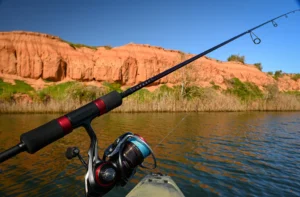Fishing Rod
When it comes to the art of fishing, having the right tools can make all the difference between a successful day on the water and a disappointing one. While many anglers focus on selecting the perfect bait and location, one often overlooked yet essential component is the fishing rod. Today, we delve into the world of fishing rods, exploring their different types, materials, and how they can enhance your fishing experience.

Understanding Fishing Rod Basics
Before diving into the intricacies, it’s important to grasp the fundamental components of a fishing rod. From the grip to the reel seat, guides, and the blank (the rod’s main body), each element plays a crucial role in the rod’s performance and functionality. We’ll explore how these components work together to create a balanced and efficient fishing rod.
Types of Fishing Rods
There is no one-size-fits-all fishing rod, as different fishing techniques and target species call for specific rod designs. Whether you’re a freshwater angler, saltwater enthusiast, or prefer fly fishing, there is a rod tailored to your needs. We’ll discuss the most common types, including spinning rods, casting rods, fly rods, and specialized rods like surf rods and ice fishing rods, highlighting their unique features and applications.
Materials Matter
Fishing rods come in a variety of materials, each offering distinct characteristics that affect performance, durability, and sensitivity. Graphite, fiberglass, and composite materials are commonly used in rod construction, and understanding their strengths and weaknesses can help you make an informed decision when choosing a rod that suits your fishing style and preferences.
Matching Rods with Fishing Techniques
Different fishing techniques require specific rod attributes to optimize performance. Whether you’re finesse fishing for bass, trolling for salmon, or casting for trout, we’ll explore how to select the right rod length, power, and action to enhance your technique. Understanding these factors will help you achieve better casting distance, accuracy, and control, ultimately increasing your chances of a successful catch.
The Pursuit of Sensitivity
Sensitivity is a crucial aspect of any fishing rod, as it allows anglers to detect subtle movements and bites. We’ll discuss how rod materials, construction, and design contribute to sensitivity, and why it’s essential to choose a rod that enables you to feel even the slightest nibble. Enhancing sensitivity can significantly improve your ability to detect fish activity and increase your catch rate.
Finding the Perfect Balance
A well-balanced fishing rod is not only more comfortable to handle but also reduces fatigue during long hours on the water. We’ll explore how the weight distribution between the rod’s handle and the rest of the components affects balance, and provide tips on achieving the optimal balance for your fishing rod setup.
Also Red –The Ultimate Guide to Fishing Unveiling the Serene Water world of the USA
Realme 11 Pro 5G Review
Here’s a step-by-step process for selecting a fishing rod:
Determine your Fishing Style and Target Species
- Consider the type of fishing you’ll be doing, such as freshwater, saltwater, fly fishing, trolling, casting, etc.
- Identify the target species you’ll be fishing for, as different fish may require different rod specifications.
Research and Gather Information - Read fishing magazines, online resources, and product reviews to gain knowledge about different brands, models, and their features.
- Seek recommendations from experienced anglers or visit local fishing tackle shops for expert advice.
Consider Rod Length - Longer rods generally provide greater casting distance, while shorter rods offer more precision and control.
- Decide on the optimal rod length based on your fishing style, the type of water you’ll be fishing in, and any casting restrictions you may encounter.
Determine Power and Action - Power refers to the rod’s strength and its ability to handle different fish sizes. Options typically range from ultra-light to heavy power.
- Action describes how much the rod bends and where that bend occurs. Options include slow, medium, fast, or extra-fast action.
- Consider the target species and the type of lures or bait you’ll be using to choose the appropriate power and action for your rod.
Choose the Right Material - Common rod materials include graphite, fiberglass, and composite (a mix of graphite and fiberglass).
- Graphite rods are lightweight, sensitive, and offer excellent responsiveness.
Fiberglass rods are more durable and flexible, making them suitable for heavy-duty fishing. - Composite rods combine the best qualities of graphite and fiberglass for a balanced approach.
Test the Feel - Visit a local fishing tackle shop to physically handle and test different fishing rods.
Pay attention to the rod’s weight, balance, grip, and overall comfort when holding and casting it. - Test the rod’s sensitivity by lightly tapping the tip and feeling for the vibrations.
Set a Budget - Determine how much you’re willing to spend on a fishing , keeping in mind that quality rods can vary significantly in price.
- Consider the long-term value and durability of the rod when evaluating its cost.
Make the Purchase - Once you have gathered all the necessary information and tested different rods, make an informed decision based on your preferences, fishing style, and budget.
- Purchase the fishing rod from a reputable dealer, either in-store or online, ensuring that it comes with any warranties or guarantees.




